Choosing the right electronic signature platform is essential when trying to streamline your document workflows.
DocuSign is a well-established player in the digital signature space and is trusted by thousands of businesses across the world.
The platform features hundreds of integrations and a seamless signing interface.
However, it’s the only signature solution out there.
Foxit eSign — while not as well-known — also offers robust and affordable signature solutions.
This platform offers standalone e-signing and an accompanying PDF editing solution (sold separately).
So, which platform is the right fit for your unique needs?
Here’s a closer look.
Key takeaways
- DocuSign offers a comprehensive suite of features and integrations, but is limited by high prices, transaction limits, and a limited use case.
- Foxit eSign provides competitive pricing and looser transaction limits, but lacks some advanced features found in DocuSign.
- PandaDoc strikes a balance between these platforms, offering great features, competitive pricing, and a new way to handle document production.
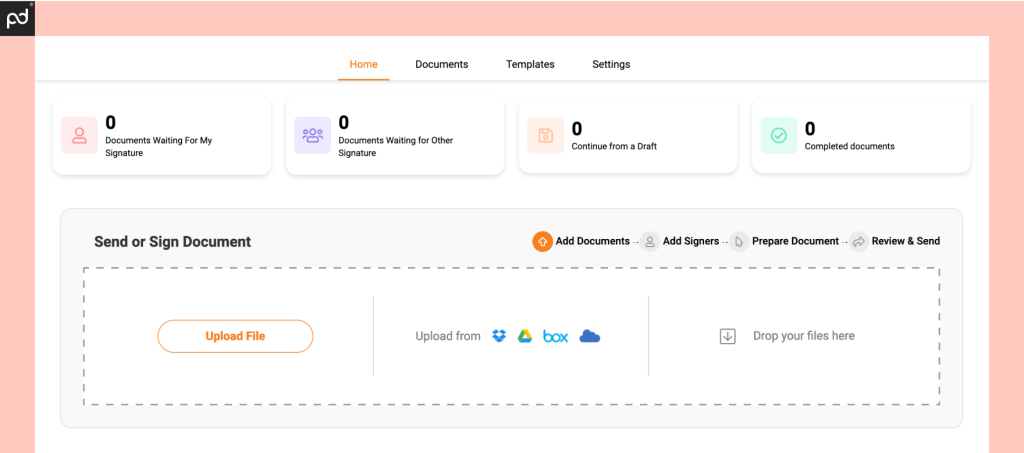
Foxit eSign
Pricing: eSign ($96); eSign Pro ($300); eSign Enterprise. All pricing based on annual commitment. No monthly option available.
Ease of use: 9.1/10
Free trial: Yes; 30 days.
Support: Knowledge base; support tickets; phone.
A lesser-known solution in the e-signing world, Foxit eSign (formerly eSign Genie) has been a part of Foxit Software since 2021.
The company provides a user-friendly solution to help companies manage PDFs and is more widely known for its extensive PDF editing suite.
Beyond capturing e-signatures, Foxit eSign helps users prepare, send and track documents with ease.
At higher tiers, integration options with Salesforce, Microsoft, and other platforms are also available.
This functionality can be critical for companies seeking robust customer data and document management solutions.
However, it’s worth pointing out that Foxit eSign (electronic signature software) and Foxit PDF Editor (PDF reading, modification, and customization) are two entirely separate software solutions.
While Foxit offers both tools as part of its PDF suite — similar to Adobe’s Acrobat Sign — you’ll need to make sure you pick up the right software solution for that.
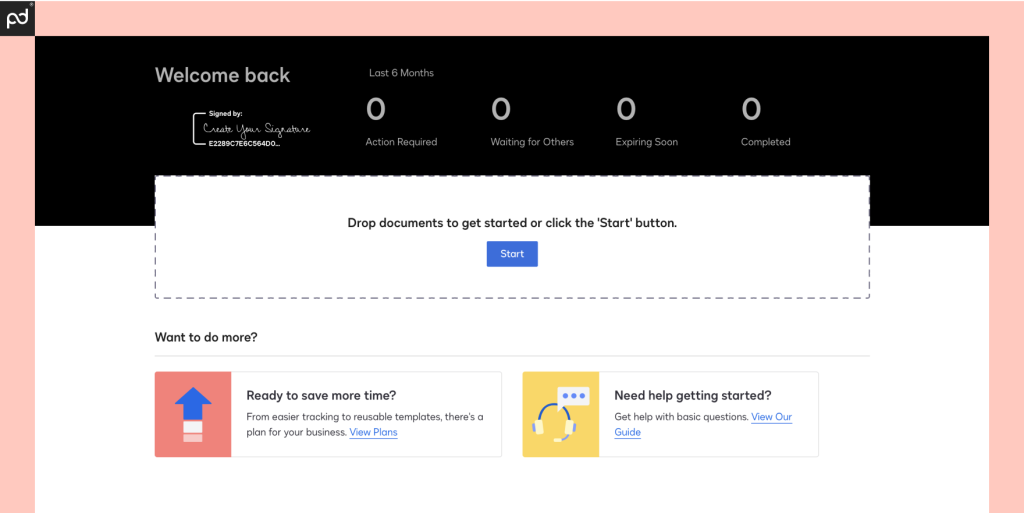
DocuSign
Pricing: Personal ($15); Standard ($45); Business Pro ($60). Enterprise pricing available. All pricing based on month-to-month commitment.
Ease of use: 9.0/10
Free trial: Yes; 30 days.
Support: Knowledge base; support tickets; additional support plans sold as separate packages.
A leading name in the e-signature space, DocuSign is trusted by businesses around the world.
This platform is known for its comprehensive features, robust integrations, and ease of use.
While the brand also offers document generation and lifecycle management tools, its core offering centers around its e-signature platform.
This toolkit enables users to automate signing workflows, securely store documents, and create detailed audit trails.
Many of these features are commonplace in other e-signing tools.
Due to its well-established reputation, DocuSign is still a popular choice for businesses.
However, its high price and limitations around transactions / functionality (especially when compared to newer signing platforms) means that it may not be the best fit for many users.
Foxit eSign vs DocuSign at a glance
Want to see how Foxit eSign and DocuSign compare to one another?
While we’ll cover both platforms in greater detail below, here’s a quick look at a similar set of plans offered by both companies.
| Plan Details | DocuSign | Foxit eSign |
|---|---|---|
| Plan Name | Standard | E-Sign Pro |
| Core product | ||
| E-signature capture | ✓ | ✓ |
| Real-time audit trail | ✓ | ✓ |
| Notifications | ✓ | ✓ |
| Language support | ✓ | Limited |
| Mobile app | ✓ | ✓ |
| Reporting tools | ✓ | ✓ |
| E-signing features | ||
| Signing order | ✓ | ✓ |
| Send to multiple recipients | ✓ | ✓ |
| Bulk send | X | X |
| In-person signing | ✓ | X |
| Collaboration tools | ✓ | X |
| Signer attachments | X | ✓ |
| Payment gateway | X | X |
| Document prep | ||
| Drag & drop fields (PDF) | ✓ | ✓ |
| Create reusable templates | ✓ | 50 |
| From-scratch document builder | X | X |
| Pre-built template library | X | X |
| Form creation | X | ✓ |
| Custom branding | ✓ | ✓ |
| Integrations & API | ||
| Import & storage | ✓ | ✓ |
| CRM | X | X |
| Productivity | ✓ | ✓ |
| API | $ | X |
| Support | ||
| Email / ticketing support | ✓ | ✓ |
| Chat support | X | X |
| Knowledge base | ✓ | ✓ |
| Phone | X | ✓ |
| Premium support options | $ | X |
In the chart above, we’ve compared Foxit’s top-tier plan (eSign Pro) and DocuSign’s midrange plan (Standard).
These plans cost roughly the same and give a great representation of features for price.
With that in mind, other plans are available:
- DocuSign offers a more expansive Business Pro plan $65/month (monthly) or $40/month (annual) per user. Enterprise plans are also available.
- Foxit doesn’t offer a more robust e-signing solution before its enterprise plan, but it’s possible to pick up PDF editing and e-signing by purchasing the PDF Editor Suite.
While you’ll have plenty of options to choose from, both also come with transaction limits that will fluctuate, depending on your plan.
These limitations are essential to understanding plan usage, so we’ve listed them below:
- DocuSign limits users to 100 envelopes per user/year. (Full breakdown of DocuSign pricing limitations here.)
- Foxit limits users to 250/500 transactions per year, depending on the plan.
Envelope and transaction limits are essentially the same thing.
These usage caps restrict how many times you can use the platform to send documents over the course of a year.
This is also a sticking point for many power users.
Teams who need to send a high volume of documents can find themselves stymied by DocuSign’s limitations.
These can be raised by speaking with DocuSign’s sales team, but doing so will incur higher usage costs.
By comparison, users on Foxit’s eSign Pro plan can send five times the number of documents before reaching the transaction limit.
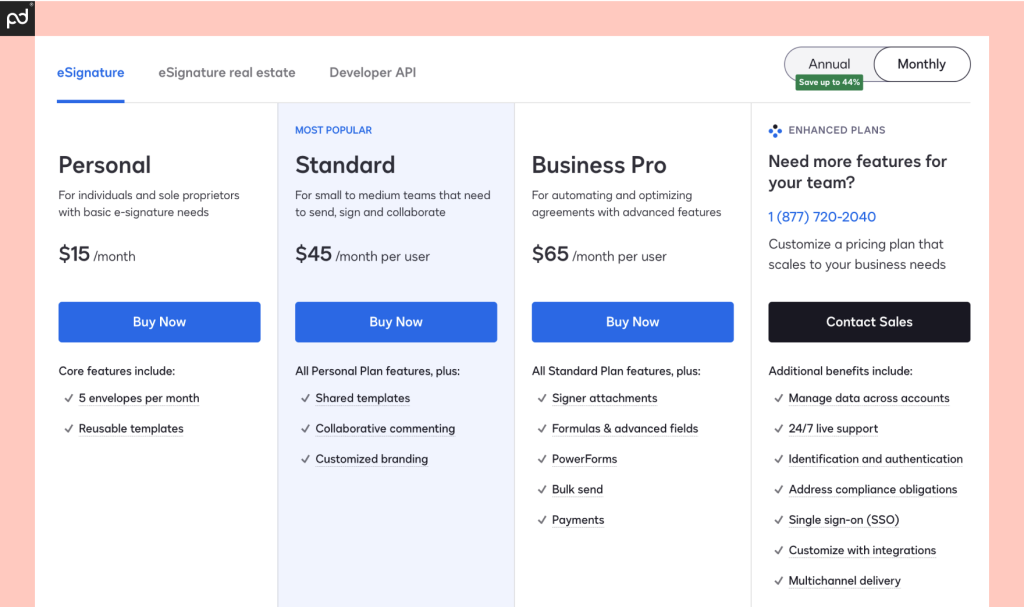
Requirements, workflows & pricing
Both Foxit eSign and DocuSign deliver a similar set of features for users, provide a similar experience, and offer some expansion methods worth noting.
Overall, DocuSign offers a wider selection of pricing tiers and user functionality, especially at the enterprise level, where the e-signing workflow meshes well with the platform’s array of document generation and lifecycle management tools.
However, the document workflow is largely the same regardless of user tier, higher-priced plans are equipped with additional features that allow for additional automation and styling.
For example, the Business Pro plan features custom branding, while the Enhanced (enterprise) plans offer HIPAA compliance options and connectivity with popular CRM tools.
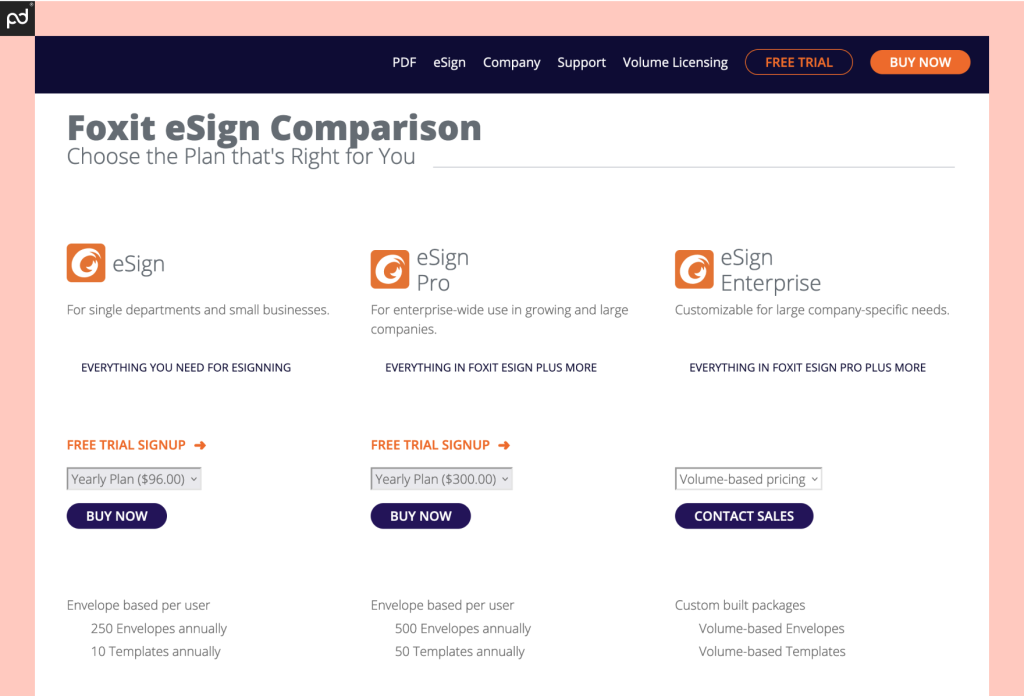
While Foxit offers a similar signing workflow to DocuSign, it manages to do so at a much lower cost and with fewer restrictions.
This includes extras like custom branding, form embedding, HIPAA compliance, and more.
Although not included with its e-signing service by default, Foxit also offers a PDF editing tool similar to what users would find on the Adobe Sign platform (full review here).
These features aren’t as powerful as the from-scratch document creation provided by PandaDoc, but it’s a notable step up from the basic drag-and-drop builder that DocuSign provides.
Unlike many of the other DocuSign tools, which stand apart from its e-signing software, Foxit’s PDF editor and e-signing services can be combined into a single software to create an even better solution around document management.
If you’re looking for better ways to handle your documents, this is a great approach.
Our suggestion
While both DocuSign and Foxit offer basic PDF editing solutions, it’s possible to go beyond the standard drag-and-drop interface to create a more robust document experience.
This is becoming more common in the e-signing space, but DocuSign and Foxit have moved in different directions with their supplemental features.
- DocuSign offers a standard e-signing solution suitable for most businesses, but additional features come at a high cost.
- Foxit’s digital signature workflow is similar to DocuSign and can be easily supplemented with native PDF editing tools for a small fee.
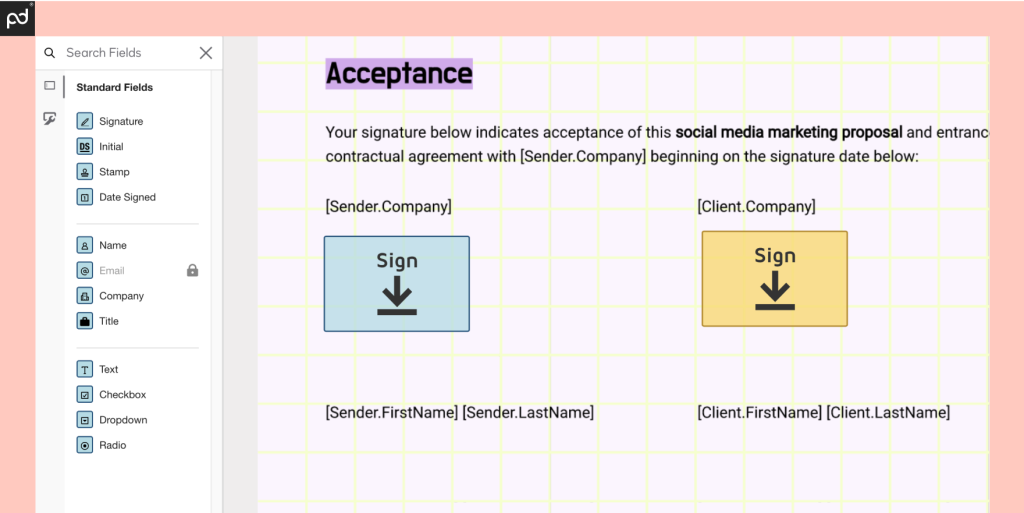
Document preparation & e-signing
As an e-signing platform, DocuSign is primarily centered around document preparation and signature capture.
Users will need to upload completed documents from external sources (Microsoft Word, Google Docs, etc.).
This is a common approach with most e-signing solutions.
With the rare exception provided by brands like PandaDoc and Proposify, documents need to be completed elsewhere before being handed over to an e-signing platform.
From there, users will leverage the DocuSign interface to prepare documents with drag-and-drop signing fields (and other tools) before sending the document to intended recipients through the DocuSign platform.
Users accessing DocuSign documents won’t need to create an account.
Instead, clicking email links or signing links — the standard form of access control for most platforms — will be used as an authentication method to validate the signer.
Once documents are signed, they’re stored automatically in DocuSign’s onboard cloud storage for easy access.
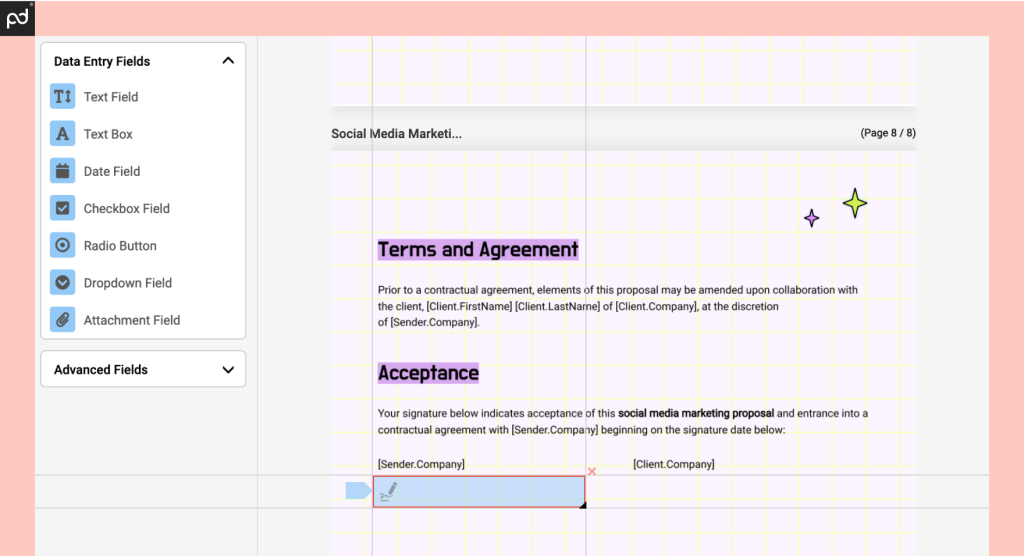
Compared to DocuSign, the Foxit experience and user interface are similar.
Users will upload documents, use drag-and-drop tools, and follow a standardized industry workflow to get documents signed.
At the price range where eSign Pro sits, users will generally have access to a larger number of features to assist with this process.
This includes advanced fields, more robust branding options, form creation, and more.
This gives users more flexibility during the preparation process — a benefit that only grows more powerful for users who pick up Foxit’s PDF Editing Suite as part of their purchase.
Unlike DocuSign, which offers supplemental tools aimed at enterprise users, Foxit’s pricing tier allows it to perform well for small- to medium-sized businesses.
Our suggestion
Overall, the e-signing process offered by DocuSign and Foxit are very similar.
As is the case with most e-signing tools, the drag-and-drop editor is designed to function with PDFs.
Although they aren’t required, it’s worth pointing out that this industry requirement makes the supplemental PDF editing tools provided by Foxit all the more useful during document preparation.
On the other hand, DocuSign’s process and related products offer great scalability at the enterprise level.
That’s important if you need to host thousands of users or hundreds of teams.
- Foxit eSign offers a great selection of tools and follows a standardized, drag-and-drop e-signing flow.
- DocuSign’s standardized e-signing experience will help teams quickly sign documents, and its supplemental infrastructure scales well to the enterprise level.
- PandaDoc, Acrobat Sign, Proposify, and other platforms offer all-in-one document editing features for users who want more than just an e-signing solution.
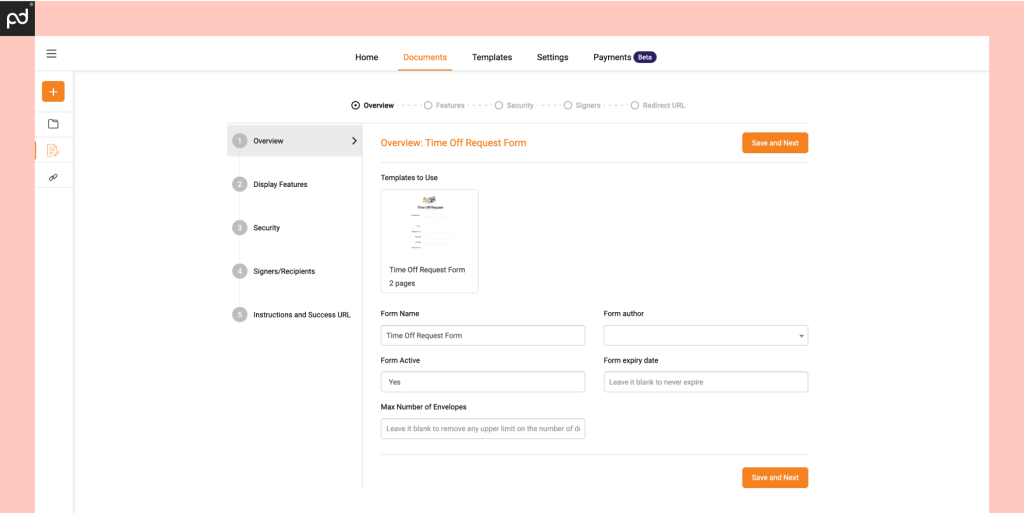
Forms, templates & integrations
Beyond their basic signing functionality, both Foxit eSign and DocuSign offer additional features to enhance document workflows.
However, these features vary significantly between platform and plan.
At the eSign Pro tier, Foxit offers a handful of features that DocuSign users won’t see without upgrading.
Notably, the platform includes basic form creation tools, allowing users to create simple forms and embed them on websites in order to collect information and signatures.
This can be particularly useful for businesses who require basic data input from clients or customers prior to finalizing their agreements.
It’s also possible to use this tool for internal paperwork and processing.
In the example above, we uploaded our own Time Off Request Form for testing purposes.
At the end of the form generation process, Foxit delivers an embeddable link that users can place on an app or web page for easy access data collection.
However, it’s worth pointing out that the form creation tools provided by Foxit aren’t as robust as you might see in dedicated form tools like Jotform.
Similar to DocuSign’s own PowerForms, these forms are essentially built by transforming a prepared document into a template and then creating a form from that template.
Moving past form generation, Foxit falls short on integrations.
The lower-tier plans offer integrations with Zapier and Google Workspace, but the majority of integrations (Salesforce, Sharepoint, Teams, API, etc.) are reserved for the Enterprise plan.
We also noticed that eSign Pro caps the number of templates at 50 per year.
While that’s a generous amount of templates, DocuSign (like PandaDoc) doesn’t have a template cap.
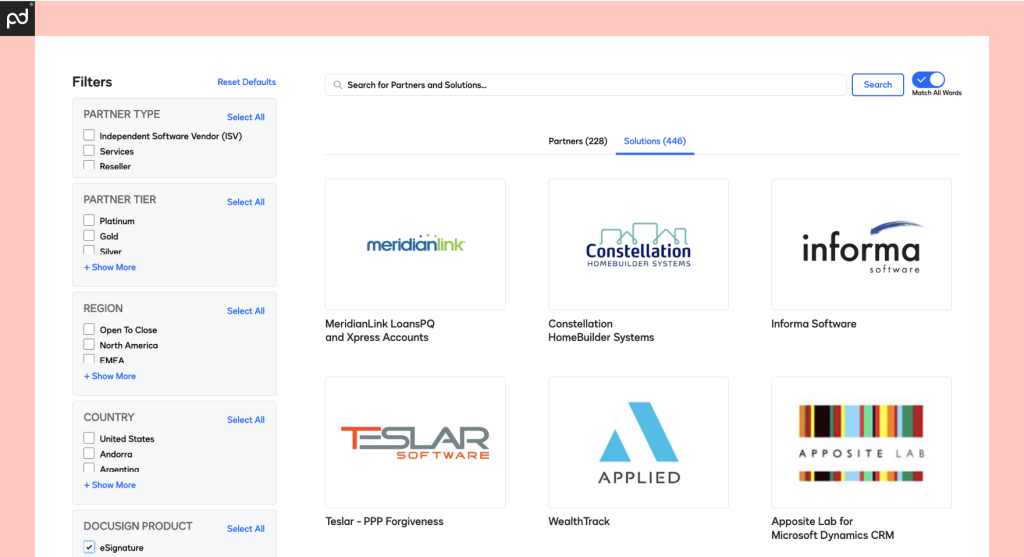
By comparison, DocuSign offers a huge selection of partner integrations at all tiers.
The most valuable integrations (CRM and ERP integrations) are reserved exclusively for enterprise users, but all partner integrations are immediately available for all plans.
This is a core feature for DocuSign and one that differentiates them from most other e-signing platforms.
The DocuSign integration library offers niche and obscure solutions that you won’t find anywhere else.
While this sounds ideal, the only solution that actually matters is the one related to your own software.
Many modern software tools can also connect via API functionality (reserved for Enhanced plans), so it’s possible to build custom integrations if yours isn’t listed.
That approach isn’t exclusive to DocuSign.
Foxit, PandaDoc, and most other e-signing platforms offer some level of API access and integration.
DocuSign is also capable of creating and handling forms, similar to Foxit, but this is only available on the Business Pro plan.
Foxit users will have access to this functionality prior to DocuSign users, but the two features are very similar.
The one major advantage that Foxit users have regarding forms comes down to volume.
Because each completed form counts against the transaction limit, DocuSign’s users can hit their 100-envelope cap very quickly when using forms.
With five times the transaction volume at their disposal, Foxit users have a clear advantage in this arena.
Our suggestion
- DocuSign offers a better selection of integrations than other platforms in the e-signing marketplace. If you’re working with obscure software, you may find a solution here.
- Foxit plans are better equipped for form usage due to the higher transaction cap. With 500 transactions available on eSign Pro — compared to 100 with DocuSign — users will be able to capture more data.

Support options
While both DocuSign and Foxit have great support options, DocuSign offers a more modular solution.
By default, all DocuSign users are placed on the Standard Support Plan, which only limits support to tools like the knowledge base and ticket submissions.
This is a major difference between DocuSign and other providers, many of whom offer more immediate or specialized customer support options.
For example, PandaDoc users enjoy 24/7/365 human-powered chat support with every plan.
DocuSign users have the ability to upgrade their support packages to various tiers, but these costs are separate from the plan costs.
Teams on upgraded plans have access to phone support, faster response times, and even API / custom integration support.

Foxit offers a similar experience to DocuSign’s Standard Support package, but the company also offers a support phone number and some chat support options (both human- and AI-powered).
You’ll also have access to the forums, a knowledge base, video tutorials, and a manual.
However, Foxit doesn’t offer premium support options like DocuSign or PandaDoc.
While it’s entirely possible to scale at the enterprise level without a larger support umbrella, DocuSign will have a clear advantage for companies who are willing to pay for expedited service.
Our suggestion
Although it won’t always be necessary, having access to support during critical periods can save plenty of time and frustrations.
Both DocuSign and Foxit are always working behind the scenes to resolve issues, Foxit gives standard users a greater selection of tools and support options when compared to DocuSign.
On the other hand, if you’re willing to pay for extra support options, DocuSign offers packages with clear response targets, priority support options, and more.
- DocuSign support plans are a great option for enterprise organizations who are willing to pay higher rates.
- Foxit offers more accessible support options for individuals and small businesses who want more than what DocuSign’s Standard Support Plans will offer.
- PandaDoc is a great option for users who want access to 24/7 chat support. We also offer premium options with phone support and a dedicated account manager.
Alternatives to Foxit eSign & DocuSign
While DocuSign and Foxit eSign are both excellent e-signature platforms, they aren’t the only options available in the market today.
Several other companies offer compelling alternatives with unique features and pricing structures.
Here are a few to consider:
- PandaDoc
- Dropbox Sign (formerly HelloSign)
- Adobe Acrobat Sign (formerly Adobe Sign)
- SignNow
- SignRequest
Most of the platforms listed above offer a free trial or a demo, so you can get a good feel for how the software functions, whether or not it will be a good fit, and what can be done with it.
You can also check out user reviews, whether or not they have mobile apps for your preferred operating systems (Android, iOS, etc.), how team permissions work, and more.
If you’re not sure where to start, PandaDoc is a great choice.

Documents made easy — with PandaDoc
Choosing between e-signing solutions like DocuSign and Foxit can be a tough call.
Both platforms have their strengths and weaknesses, and both are trying to fill the same gap in the document process.
If you’re looking for a better balance between functionality, affordability, and ease of use, PandaDoc may be your best bet.
Here’s a closer look at what we bring to your document process:
- Powerful document creation. Create professional-looking documents completely from scratch.
- Advanced workflow. Automate document routing, approvals, and reminders to eliminate manual tasks and reduce errors.
- Seamless e-signing. Collect legally binding e-signatures on any device. Includes real-time tracking and notifications.
- Extensive integrations. From CRMs to productivity tools, add your document workflow to the rest of your tech stack.
- Affordable pricing. Choose a plan that fits your budget and scale as your business grows.
And don’t take our word for it!
Check our customer reviews or sign up now for a 14-day trial and see for yourself how PandaDoc can transform your entire document workflow.
Disclaimer
PandaDoc is not a law firm, or a substitute for an attorney or law firm. This page is not intended to and does not provide legal advice. Should you have legal questions on the validity of e-signatures or digital signatures and the enforceability thereof, please consult with an attorney or law firm. Use of PandaDocs services are governed by our Terms of Use and Privacy Policy.
Originally published May 11, 2022, updated July 12, 2024


